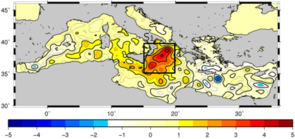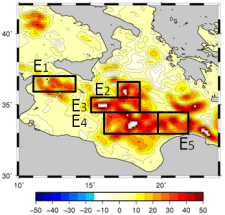Ionian Sea circulation
The Ionian Sea is the crossroads of waters connecting the Western and the Eastern Mediterranean basins with the Adriatic and the Aegean Seas. Its circulation is highly variable and characterized by two main states: a cyclonic or an anticyclonic circulation. An indicator based on a combination of a standardized sea level average and of standardized Eddy Kinetic Energy, well checks these two different states.
The dominant low-frequency dynamic of the Ionian Sea over the last twenty years is characterized by a decadal oscillation of its circulation, with two rather different states associated with a circulation reversal in the Northern part of the Sea.
The "anticyclonic" state is characterized by an anticyclonic gyre in the Northern part of the Ionian basin. It is associated with a weak quasi-zonal jet crossing the Ionian Sea from West to East.
The "zonal-cyclonic" state is related to a reversal of this Northern gyre (which becomes cyclonic). Its associated with an intense current crossing the basin at its center.

Ionian Sea circulation indicator, combining Sea level anomalies averaged on one box, and Eddy Kinetic Energy averaged over several smaller boxes.
The "anticyclonic state" corresponds to the presence of an anticyclonic gyre in the Northern part of the Ionian basin and is associated with a weak jet crossing the Ionian Sea from West to East. Conversely, the "cyclonic state" is related to a reversal of this North Ionian Gyre (then cyclonic) and is associated with an intense mid-Ionian jet.
During anticyclonic time period, the Atlantic Ionian Stream entering the Sicily Strait bifurcates almost exclusively north-eastward in the Ionian. There it meanders anticyclonically, bringing Modified Atlantic Waters into the Ionian interior and eventually into the Adriatic before reaching the Levantine basin via the Cretan passage. In contrast, during cyclonic phases the Atlantic Ionian Stream is prolonged Eastward by an intense Mid-Ionian Jet, what conveys Modified Atlantic Waters directly from the Sicily Strait to the Cretan Passage and the Levantine basin by the shortest route. Under cyclonic mode, the circulation pattern contributes to spread the eastern Mediterranean waters westward into the Ionian interior (with possible incursion into the Adriatic).
Between these two main states the Ionian Sea circulation has many intermediate states of transition and presents either progressively weakening or strengthening trends.
To compute an indicator on such a phenomena, that manifests as both gyre and quasi-zonal jet, both sea level and eddy kinetic energy variabilities must be taken into account, as study shows [Bessière et al., 2012]. The Ionian circulation indicator is thus a combination of a standardized sea level average over a defined box, and of standardized Eddy Kinetic Energy, also averaged, but on several different small boxes.
For more information:
- Image of the Month, March 2001: Mean rise in sea level is only part of the story
- Image of the Month, September 2006: Mediterranean currents
References (and details of the computation)
- Bessières, L., M.H. Rio, C. Dufau, C. Boone, M.I. Pujol, 2012: Ocean state indicators from MyOcean altimeter products, Ocean Sciences, doi:10.5194/osd-9-2081-2012







